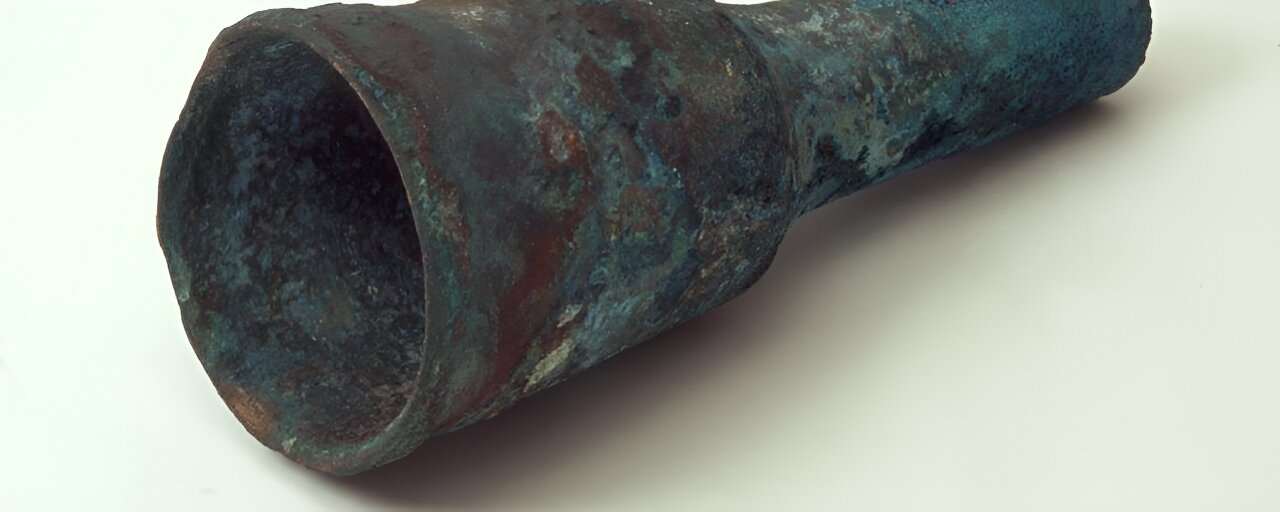Nedovezl z Číny?  Ne. jen vtip. Zajímavej článek
Ne. jen vtip. Zajímavej článek
Amateur diver discovers what is believed to be the oldest cannon in Europe
Categories: Nálezy nejenom s detektorem ve Skandinávii , Nálezy nejenom s detektorem kovů v mořích a oceanech
A cannon from the 14th century was discovered in the sea off the west coast of Sweden. According to an international research team led by maritime archaeologist Staffan von Arbin from the University of Gothenburg, it is probably the oldest ship's cannon in Europe. It provides an insight into the early period of naval weaponry and takes the history of this type of gun forward by at least a century.
The cannon was discovered in 2001 was in the open sea about 5 kilometres southwest of the island of Marstrand. It lay at the foot of the large Hannehakarna shoal, partially buried in sediment about 20 metres below the surface. It was discovered by a local diver who at first did not understand what he had found, but managed to bring the heavy piece to the surface. Some time later, he realised the importance of his find and informed the Maritime Museum in Gothenburg.
Since all old objects made of gold, silver, copper or any copper alloy are cultural objects under Swedish legislation.the weapon was expropriated, preserved and later incorporated into the collections of the Bohuslan Museum. A recent interdisciplinary study published in the English journal The Mariner's Mirror describes the early phase of the development of artillery on land and at sea and tells of a turbulent period in the 14th century. In doing so, it studied the small funnel-shaped muzzle-loading cannon just mentioned.
In the 14th century, the town of Marstrand was an important hub for merchant shipping between Western Europe and the Baltic Sea regions. The sea was then a pirate paradise, a breeding ground for wars and various conflicts, which also took a heavy toll on the civilian population on the coast. New types of firearms provided great tactical advantages in naval battles. In the late Middle Ages, merchant ships also began to be equipped with guns to defend themselves against pirates and other enemy vessels. The Marstrand gun provides new insights and perspectives on the development of this military technology.
Researchers have concluded that it is a purpose-built ship's gun, not a transported as cargo, because at the time of its discovery, there were still remnants of parts of the charge in the powder chamber. The gun was loaded and ready for use in combat when it sank. "Thanks to the preserved remains of the charge, it was possible to use radiocarbon dating to determine the age of the find," Staffan von Arbin said. "The results of the study show that the cannon probably dates back to the 14th century, making it one of the oldest cannons ever found in Europe," he added.
The researchers documented the find using 3D scanning and also carried out a chemical analysis of the metal used to cast the cannon. The results showed that it is a copper alloy containing about 14% lead and only a small amount of tin. According to the researchers, this alloy is far from optimal for a cast cannon, and it is likely to crack and become unusable with prolonged heavy use.
"It is clear that the casters of the time did not have the necessary knowledge to understand the properties of the different copper alloys," Staffan von Arbin explained. "This shows that at that time the noble art of casting had not yet been fully mastered. and that production was largely based on trial and error," the archaeologist explained the reason for the inappropriate alloy ratio.
The analysis further describes that the copper ore used in the production of the cannon was mined in what is now Slovakia, while the lead probably came from the border area between Poland and the Czech Republic or from England. In addition to the results of the analyses, scholarly discussions of the find in the light of documentary, iconographic and archaeological sources have also been published.
Funnel-shaped cannons of the Marstrand type are usually dated to the 15th-16th centuries, but this find indicates their existence as early as the 14th century . The preserved remains of the charge in the gun's powder chamber also prove that cartouche fillings (such astextile "wrappers" for powder charges) came into use much earlier than previously known.
"Now, of course, we also want to try to locate and document the ship to which the cannon belonged. Although it is probably badly degraded and broken, we could find scattered remnants of the wreck if we conduct a thorough inventory of the site and its surroundings," Staffan von Arbin concluded.
Roman Němec
Sources: phys.org, gu.se, tandfonline.com

Marstrand cannon

Views

The cannon dates back to the 14th century

Photograph of the barrel bore with the remains of the cartridge in the mouth of the powder chamber

the site of the discovery
The article is included in categories:



